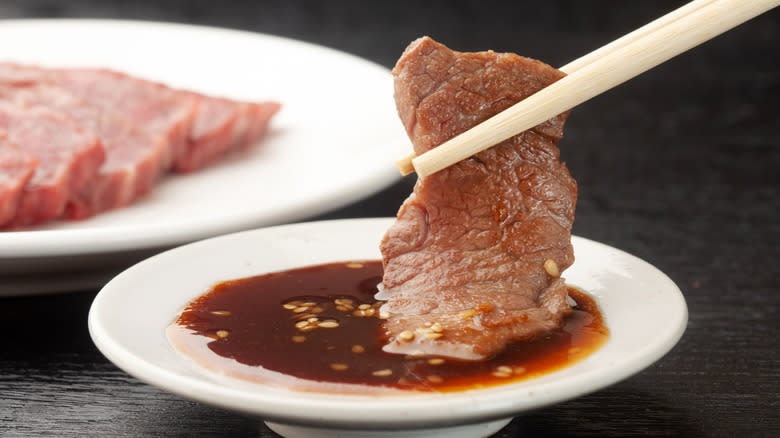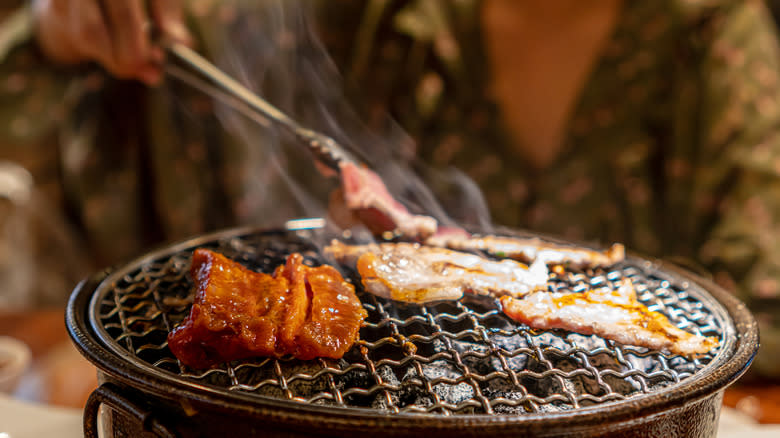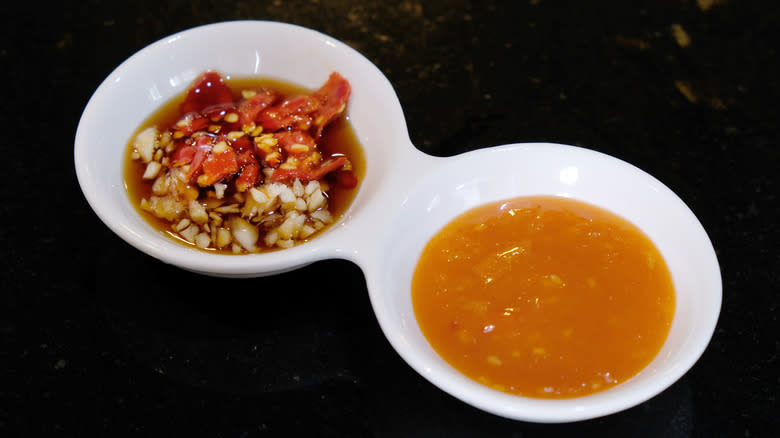Yakiniku Sauce Is The Ultimate Japanese Condiment For Grilled Meats

When you picture a sauce for grilled meat, what jumps to mind? Probably barbecue sauce -- and there's nothing wrong with that. In the U.S. alone, we have a plethora of barbecue sauces to choose from spanning South Carolina's tangy mustard sauces to the sweet molasses-based Kansas City style. But beyond our border, there are countless more sauces intended for flame-licked proteins. In South America, herby chimichurri is liberally spooned over grilled beef. Lebanese chefs and cooks often serve up garlicky toum with grilled items.
And, in Japan, much like in the U.S. with our barbecue sauce selection, there is an entire class of multipurpose sauces called tare that can be used as soup bases, condiments, and marinades. Of the various tare, yakiniku sauce stands out as a savory, sweet, and pungent sauce that adds layers of complexity and richness to the grilled meats it dresses.
Quite possibly the best known and most basic tare is teriyaki sauce, which combines soy sauce, mirin, and sugar to create an umami-laden sweet sauce that caramelizes on the grill. Other tare sauces build on this classic base. Yakiniku, which translates to "grilled meat" -- a term for the style of cooking it accompanies -- takes the teriyaki base a few steps further with the addition of garlic, sesame oil, and sesame seeds. It can either be brushed on the meat before grilling to glaze it, used as a dip after the meat comes off the grill, or both.
Read more: The Most Popular Cuts Of Steak Ranked Worst To Best
What Is Yakiniku?

Japan has a long tradition of yakiniku, or grilled meats, as a style of cooking. Korean immigrants to Japan are often credited with introducing yakiniku, a riff on their own indigenous grilling. Originally, bits of beef and pork offal and less-desirable cuts of meat were quickly grilled over hot coals right in front of customers in market stalls. These skewers were a quick, nutritious, and economical option. Further, during the reign of Emperor Meiji in the late 19th century, beef was promoted as a popular protein in the rapidly-industrializing country.
Yakiniku cooking took off, though, in the period after World War II. Immediately after the end of the war, food shortages were common, leading industrious chefs and vendors to seek out every available scrap of meat for quick grilling. The style took root, and as Japan's economy roared back to life and American beef became readily available, yakiniku became more acceptable and popular.
Proper yakiniku restaurants began to appear where customers could order various kinds of meats to be grilled at their table over charcoal, electric, or gas grills. This is also when tare sauces, like yakiniku sauce, began to become ubiquitous. Today, diners can choose from a number of different cuts of pork, beef, and chicken -- including filets, ribs, skin, hearts, liver, and gristle -- all to be grilled to their liking and dunked in the sweet, savory yakiniku sauce.
How To Make Yakiniku Sauce

Tare sauces are very chef specific, with each putting their own spin on the sauce they serve. Some may choose to add more or less of a specific ingredient, substitute items like honey for the sugar, or add in extras like fruit juice or aromatics. Yakiniku sauce is much the same, but for our purposes here we'll be focused on the commonly agreed upon base for a standard recipe.
Making yakiniku sauce is fairly straightforward. In a saucepan, you combine soy sauce, which constitutes the body of the yakiniku sauce, with a few tablespoons of mirin, sake, or both, a few tablespoons of sugar, a few teaspoons of sesame oil, and a minced clove of garlic. Allow that to reduce over medium heat until the sugar is dissolved and the alcohol from the mirin has evaporated. Next, allow the yakiniku to cool a bit before straining out the minced garlic and adding in both black and white sesame seeds.
As with many great sauces, yakiniku is highly customizable. If you prefer sweeter or less sweet sauce, modify the amount of sugar you put in. For a more acidic version, add a small amount of vinegar. Ginger can also be minced and added along with the garlic for a warm aromatic note. Still others add the garlic after reducing the sauce for a more pungent bite.
Read the original article on Tasting Table.

